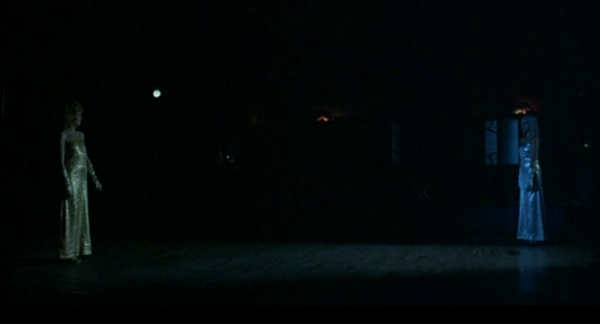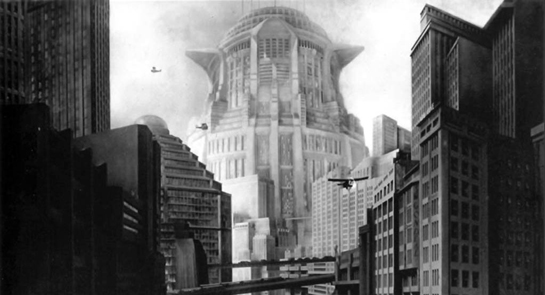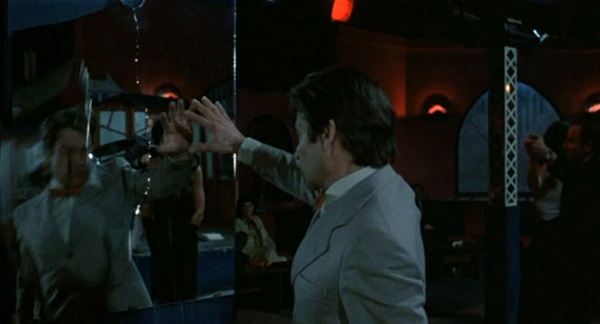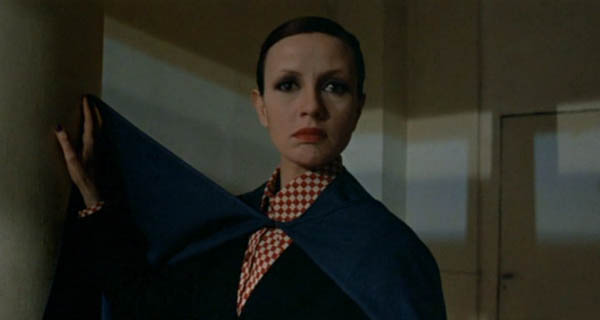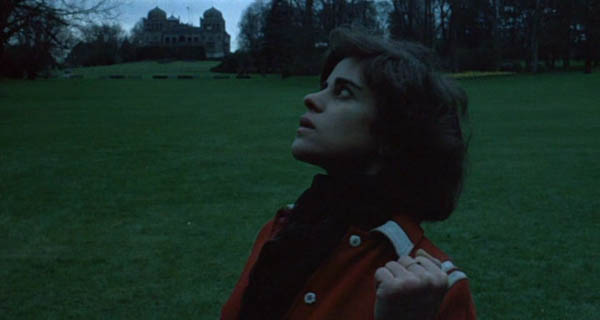This essay, published in Film Comment in September-October 1976, represented one particular round in a series of initiatives and polemical forays I conducted on behalf of Jacques Rivette’s Duelle, which included getting it into the Edinburgh International Film Festival that year (and then writing about that festival at length in the Winter 1976/77 issue of Sight and Sound). One part of my effort was to engage the attention and interest of writers associated with the English theoretical magazine Screen, and this portion of the effort mainly failed: the principal response of the Screen writers who bothered to see it, as I recall in terms of their comments to me, was that it was basically warmed-over Cocteau and/or Franju — a reaction that I consider now, as I did then, to be rather obtuse and philistine. On the other hand, I no longer relish Duelle with quite the same fervor that I did at the time, even though there are certain moments in Jim Jarmusch’s very pleasurable The Limits of Control, that remind me of it. (Nowadays I prefer L’amour fou, both versions of Out 1, and Celine and Julie Go Boating — for me the peaks of Rivette’s work.) This article may be somewhat dated in other respects as well, but I still rather like the way that I use Barthes, the Tower of Babel, and Patti Smith. — J.R.
DUELLE: Notes on a First Viewing
By Jonathan Rosenbaum
“Imagine someone (a kind of Monsieur Teste in reverse) who abolishes within himself all barriers, all classes, all exclusions, not by syncretism but by simple discard of that old specter: logical contradiction; who mixes every language, even those said to be incompatible; who silently accepts every charge of illogicality, of incongruity; who remains passive in the face of Socratic irony (leading the interlocutor to the supreme disgrace: self-contradiction) and legal terrorism (how much penal evidence is based on a psychology of consistency!). Such a man would be the mockery of our society: court, school, asylum, polite conversation would cast him out: who endures contradiction without shame? Now this anti-hero exists: he is the reader of [a] text at the moment he takes his pleasure. Thus the Biblical myth is reversed, the confusion of tongues is no longer a punishment, the subject gains access to bliss by the cohabitation of languages working side by side: the text of pleasure is a sanctioned Babel.”
–Roland Barthes, The Pleasure of the Text
“…on the Tower of Babel, they knew what they were after…”
–Patti Smith, “Land”
Suppose that someone reads the above paragraph by Barthes without quite understanding or identifying “Monsieur Teste” (a character invented by Valéry) , “syncretism” (“The reconciliation or union of conflicting beliefs,” begins my Merriam-Webster), or “Socratic irony”. Like anyone watching Jacques Rivette’s DUELLE for the first time, he skips or skims or swaggers or stumbles his way through, picking up what he cans and what he wants; and whether he knows it or not, he knows what he is after. Skipping a bit of Barthes, we read that
“We do not read everything with the same intensity of reading: a rhythm is established, casual, unconcerned with the integrity of the text; our very avidity for knowledge impels us to skim or to skip certain passages (anticipated as “boring”) in order to get more quickly to the warmer parts of the anecdote (which are always its articulations: whatever furthers the solution of the riddle, the revelation of fate): we boldly skip (no one is watching) descriptions, explanations, analyses, conversations […] And yet, it is the very rhythm of what is read and what is not read that creates the pleasure of the great narratives: has anyone ever read Proust, Balzac, War and Peace, word for word? (Proust’s good fortune: from one reading to the next, we never skip the same passages.)”
This isn’t merely the way one “reads” roughly the first half of DUELLE, but the way that it conjures up itself: boldly skipping certain descriptions and explanations, or at the very least postponing them, swaggering and stumbling with the unpredictability of any grand experiment. In our attempts to reach “the solution of the riddle,” we are occasionally obliged to move sideways into the confused excitement of our present spectator’s time across the conjunctions of diverse elements (acting, directing, setting, plot, dialogue, music, etc.) at each passing moment — rather than strictly forward in a more submerged absorption in fictional narrative time.
Needless to say, this is no easy matter. Narrative habits die hard, and the burning desire to know precisely what is going on in story terms might well divert one from the fascination of not knowing what will happen next in formal terms, in the constantly fluctuating relationships between chance and control. None of the actors is improvising this time, but pianist Jean Wiener is – recorded in direct sound and often visible during ten of the thirty sequences, in the dance hall as well as other scattered locations, often suggesting the rather disconcerting transferal of a silent film accompanist from the auditorium to the screen; and the principle of Rivette’s collaborative method throughout is again to see what happens when certain foreign elements are combined, without determining the results entirely. Disequilibrium is expressed in the opening and closing shots alike: in the first, Lucie (Hermine Karagheuze) is tottering frantically in close-up, and a cut to her in medium shot shows her trying to balance herself on a huge ball (a globe of the world); in the last, she is reeling across a deserted park in a kind of lyrical delirium, reciting part of an incantation from Cocteau (quoted below) devoted to the disintegration of logic itself.
Learning to play this game profitably requires to some degree an inversion of ordinary expectations: a suspension of belief. One partially accepts the fact that one can’t be sure where one “is” in relation to the film as long as one doesn’t quite know where (or who) the characters are. It takes some time to discover that Pierrot (Jean Babilée) is the brother of Lucie, and that Leni (Juliet Berto) and Viva (Bulle Ogier) are competitive goddesses — daughters of the moon and sun, respectively – enlisting Lucie, Pierrot and other mortals in their search for a diamond that will keep them alive on earth past their annually allotted forty days, between the last new moon of winter and the first full moon of spring. Consequently, the interpolated shots of a progressively waxing moon are initially as enigmatic as some of the black and white stills punctuating OUT 1: SPECTRE. And we may never work out that Elizabeth (Elizabeth Wiener), the woman who first appears at the racetrack and in the clandestine gambling den with Viva, is the latter’s earthly assistant, a fact quite evident in the pre-shooting synopsis prepared by Eduardo de Gregorio, Marilu Parolini, and Rivette, the screenwriters.
The irony of this situation is that the plot is important chiefly as a vehicle, and one mainly has to “know” it only in order to be able to dispense with it. Goddesses searching for a diamond: what could be sillier? And yet, on the other hand, what could be more typical of a form where deities known as stars struggle with one another to grapple after equivalent prizes? Rivette’s movies are like other movies – only more so. People who find them “less so” are merely stumbling over the fact that he periodically abstracts the familiar ingredients. But in the same gesture, he shows us essential aspects of what always happens to us in movies, which a lifetime of filmgoing has taught us to ignore: breaks in legibility, ruptures of tone, momentary disorientations or encumbrances that we usually skip over or skin when we encounter them on a printed page. In DUELLE, however, we must pass through them, even if “we do not read everything with the same intensity of reading”.
***
The central importance of the Tower of Babel in Rivette’s work can be traced back to the clip from METROPOLIS in PARIS NOUS APPARTIENT, and the implicit perspective it gave to the characters’ overlapping “paranoid” fantasies. In SPECTRE, these fantasies went beyond a purely thematic level to become the conflicting “languages” of different acting styles, and the fictions underlying them. In DUELLE, the conflicting languages become such formal elements as plot, dialogue, music, natural sounds, editing, mise en scène — a collection of sign systems which each speaks in its own language. Conventional illusionist cinema rests on the premise that all these sign systems can speak “together” to utter a single meaning, generally a transcendent one (on the Tower of Babel, they knew what they were after); but this is an idealistic delusion, however seductive the results might be. The seduction of DUELLE is to foreground this delusion (embodied, in a way, by the transcendental diamond itself), while returning each of these sign systems to a purer state, thus allowing one to witness the primal birth of meanings and sensations when some of these ingredients start to link up. Most films, by beginning well after this process has started, deprive one of both the dangers and excitements of a spontaneous generation – offering, in its place, a kind of second-degree. But Rivette’s recent cinema takes us back to roots.
***
Place two actors in front of a camera in a Rivette movie and something strange happens: a kind of unbalanced fictional space is created, making the relationship slightly uncanny. Bulle Ogier and Jean-Pierre Kalfon in L’AMOUR FOU, Dominique Labourier and Juliet Berto in CÉLINE ET JULIE VONT EN BATEAU provide extended forms of this chemistry; SPECTRE and DUELLE are crammed with multiple examples in miniature. Working with one hero (Pierrot) and four heroines – Luci, Leni, Viva, and Elsa/Jeanne (Nicole Garcia [see below]), another mortal – the thirty sequences of DUELLE are arranged so that each character in turn becomes the central figure. This process occurs in a concentrated form in the fifteenth sequence, at the dance hall, the only time that all five characters appear together. The goddesses finally confront each other, the murky film noir starts to become a lucid film fantastique, and the mise en scène is structured around permutations of emphasis as each character slides in and out of as central narrative/screen position in counterpoint to the others, with mirror reflections playing as much of a role as the actors themselves. Like the scene occurring in the precise middle of SPECTRE (when Berto and Léaud, the two remaining loose threads in the plot, cross paths in a boutique called l’Angle du Hasard, thereby linking up all the fictional strands), this sequence is the supreme moment in DUELLE when all the elements in Rivette’s tapestry converge and disperse.
And when scenes arrive in the second half which work in the narrative/dramatic way that cinema is usually supposed to (Pierrot combating Leni with light in a hotel corridor, Elsa/ Jeanne using darkness against Viva in the empty dance hall), their conjunction of elements seems truly miraculous, like Godard’s dream to achieve “the definitive by chance”. While most films introduce conflict in the midst of equilibrium, DUELLE does just the reverse, so that scenes establishing old-fashioned suspense like the above – or old-fashioned sentiment, like Lucie’s scene with Pierrot in the underground garage – exist as reminders of what can happen when the elements of cinema synthesize to create a legible story.
***
DUELLE is labeled the second film in a four-part work with the Balzacian title SCÈNES DE LA VIE PARALLÈLE, although it is the first to be made in the series. What now appears to be the third part — a “pirate” revenge tragedy entitled NOROÎT – is in the final stages of editing, and Rivette hopes to complete first and final parts by next year. [2009 postscript: For various complex reasons, the final two parts were never completed.] Significantly, music and dance will be used with increasing frequency from the first film to the last. (For a much more detailed account of the earlier stages of this project, see my article with Gilbert Adair and Michael Graham, “LES FILLES DU FEU: Rivette X 4,” in the Autumn 1975 Sight and Sound.) Uses of dance in DUELLE include some graceful turns briefly made by Leni while circling the Schola Cantorum (see below), the stunning black- and-white passages of Pierrot defying Viva (Jean Babilée, one should note, performed Cocteau’s ballet Le Jeune Homme et la Mort in the Forties and was Leslie Caron’s partner in the Ballet des Champs-Elysées company), and the remarkably staged central scene at the dance hall described above. Concerning the music, one might imagine that the “non-diagetic” appearances of Jean Wiener at the piano (i.e., outside the dance hall) would be rather disturbing. Not at all, as it turns out; by the time we have grown accustomed to him, he has become a comfortable presence, as his offscreen music has been in LE CRIME DE MONSIEUR LANGE, LES BAS-FONDS, and LES PETIT THÉÂTRE DE JEAN RENOIR. The truly disquieting thing about him is his disappearance, after the Schola Cantorum scene; where does he go?
“There are no children here and no dogs,” asserts the doctor to the hero in Carl Dreyer’s VAMPYR, although, like the hero, we may think that we’ve heard one of each. We may be similarly confused in DUELLE by the audible presences of a train behind the opening and closing credits, the deafening birds who overtake Viva and Elizabeth’s conversation at the ritzy hotel, or the drone and faint trickle of water in the corridor of the shabby hotel where Pierrot challenges Leni. Insofar as the cinema can be seen as a form of wish-fulfillment – an ideal universe “projected” by the spectator’s mind – details that seem wrong might come from anywhere. What about the wind we see and hear in the same corridor, or Lucie’s sudden scream in the gambling den, or the direct-sound recording of the squeaks on the dance hall floor? Each spectator/auditor will compose his or her own list; and on a second viewing, any of these details might conceivably seem “right”.
A psychoanalytic reading of the plot of DUELLE (like that of de Gregorio’s otherwise very different SÉRAIL) would undoubtedly be fascinating, but to do it properly one would have to analyze it through the presence of these or comparable intrusions. Occasionally campy moments in performances, settings, costumes, and dialogue can provide odd ruptures of their own: Leni’s charge of “Impertinence!” when Elsa/Jeanne remarks on her lack of an English accent; the latter’s admission to Viva that she finds the name Jeanne “vulgaire”. Perhaps most unsettling of all is a wholly gratuitous reverse-angle cut in a scene between Pierrot and Elsa/Jeanne in her room above the dance hall, just after they kiss and she takes off her coat. Both actors are equally present in both shots, so no shift in identification is implied, merely another viewpoint – but whose? Like some of the elaborate camera movements, which might accompany part of an actor’s trajectory only to abandon it (or vice versa), it is a shift that alters our relationship to the action without any apparent independent motive.
I have recently tried to suggest elsewhere (Monthly Film Bulletin, August 1976) how certain comparable procedures in VAMPYR tend to “assert corporeal presences beyond the formal coordinates which initially define and enclose them,” creating a kind of erotic materialist fantasy. And for all the pastiche echoes In DUELLE of other films – KISS ME DEADLY, THE BIG SLEEP, THE LADY FROM SHANGHAI, TOUCH OF EVIL, THE SEVENTH VICTIM (which was screened for the cast and crew prior to shooting), LES DAMES DU BOIS DE BOULOGNE (“Je me vengerai”), ORPHÉE – it is VAMPYR which it resembles the most in terms of its overall methods. “Do you believe in a spiritual domain?” Rivette was asked in Télérama, April 1, 1962, shortly after the release of PARIS NOUS APPARTIENT – the earliest interview with him I have been able to trace. “perhaps,” he replied, “but only through the concrete. If that means being materialist, I think that’s what I am more and more.”
***
Deux et deux ne font plus quarte
Tous les murs peuvent s’abattre
1, 2, 3, 5, 6, 7, 2.
Chiffres délivrez-nous d’eux
Par le sec et par l’étanche
A cheval sur l’inconnu
–Merlin in Cocteau’s Les Chevaliers de la Table Ronde
PATRICIA: What is your greatest ambition in life?
PARVELESCO: To become immortal, and then to die.
–Godard’s A BOUT DE SOUFFLE
Immortals who want to become mortal, mortals who want to become immortal, each seeking a diamond that Viva calls the Fairy Godmother (that mythical figure who fulfills every wish): all disappear by the end but Lucie, whose possession of the diamond, now blood-red, means that her own days are clearly numbered. Are they numbered out of order like her closing chant, recited earlier by Elsa/Jeanne when she held the diamond as well? “Two and two no longer make four/All walls can be shattered…” Kissed by the radiant, transcendental light of idealism that can turn derangement into poetry, hysteria into ecstasy, language into babble, and babble into illusionist cinema (“a sanctioned Babel”) — like the talisman in Balzac’s Le Peau de Chagrin, gratifying desire and stealing life in the same magical motion – Lucie reels off into the void where all narratives lead.
“He consumed himself little by little, until he vanished,” says an early mortal victim, Sylvia Stern (Claire Nardeau), of Max Christie, Pierrot and Lucie’s predecessor. So does DUELLE itself, evolving over its forty-day period from playful obscurity to chilling illumination, arriving at an apotheosis where the separate forces of day and night, moratlity and immortality, materiality and spirituality, documentary and fantasy, pleasure and bliss finally merge to become a dying goddess staggering through an empty park at dawn.
.
—Film Comment, September-October 1976

